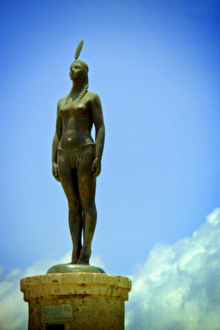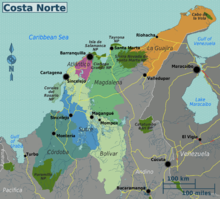India Catalina

The India Catalina (* around 1495 in Zamba; † uncertain, probably in Seville ) was an indigenous peoples of the Caribbean coast of Colombia and is considered to be one of the most important indigenous personalities of the Colombian colonial era . As the companion of the Spanish conqueror Pedro de Heredia , she was used as a translator and mediator between the conquistadors and the indigenous tribes. She had a strong influence on the conquest of the Colombian Caribbean coast at the beginning of the 16th century and on the founding of the city of Cartagena de IndiasWith. Because of her work as a mediator, she is often referred to as a “pacificatora” (peacemaker). However, this title has been criticized again and again. For a long time India Catalina was mainly regarded as a figure in Colombian mythology, until its existence was finally plausibly proven by the research of the Colombian writer Hernán Urbina Joiro in his book "Entre las huellas de la India Catalina".
Life
Catalina was the daughter of the Kaziken Galera in Zamba (today Galerazamba), a village near Cartagena de Indias . The Spanish conqueror Diego Nicuesa captured them there between 1509 and 1511, separated them from their family and brought them to Santo Domingo , the first center of the Spanish conquerors in what is now the Dominican Republic . The Spaniards then christened her with her now known name "Catalina". She was raised to the Catholic faith in Santo Domingo and learned to live and dress like a Spanish woman. There is no historical evidence of her life in the next few years. From 1528 there are reports that she worked in Santa Marta as an interpreter in the gobernación (governorship), as she spoke various indigenous languages and dialects in addition to Castilian Spanish. She saved some indigenous peoples from a violent conquest by the Spaniards by explaining the intentions of the conquerors and convincing them to officially accept the Catholic faith and submit. She always appeared dressed as a Spaniard and first addressed the women of the indigenous population groups.
Her first encounter with Pedro de Heredia took place on the night of January 12th to 13th, 1533 in Gaira, near Santa Marta. She followed him to Castillo Grande, in what is now Cartagena de Indias, to support him as a mediator in negotiations with the indigenous groups and the colonization of the region. As she was the cousin of many of the then powerful caciques in the region, she was sent ahead to establish the first contact with the indigenous groups and to convey the message of Heredias. In this way, peace was made with some important caciques, such as Mazaguapo, Guaspates and Turipaná. It was therefore of great importance for the Spaniards for the founding of Cartagena de Indias and the conquest of the Colombian Caribbean coast. According to legend, Catalina married Alonso Montañez, the nephew of Pedro de Heredia, started a family with him and moved with him to Seville , where she died of old age.
Different reception of their work
The India Catalina is a symbol and one of the most famous citizens of the city of Cartagena de Indias . The early chroniclers of colonial history portray her as a peaceful indigenous peoples who conformed to the Spanish crown and the Christian faith. This representation is occasionally used to justify the colonization of an advanced Latin America. However, their work and their title as “pacificatora” are also viewed critically, as, for example, the indigenous group of calamari was completely wiped out when Cartagena de Indias was founded, in which Catalina decisively participated. Her work and her person thus contain some contradictions. On the one hand, she is valued as a heroine because of her mediating activity; on the other hand, she is condemned as a traitor who contributed to the rapid progress of colonization. India Catalina itself has not written any reports about its work and its intentions. Existing records come from eyewitnesses, such as Spanish historians and their critics, who, due to their positions, can only be viewed as deformed and manipulated impressions, or from chroniclers who only wrote the story after the lifetime of India Catalina and thus without personal experience. Therefore, no definitive statements about their work and their position are possible.
Appreciations from India Catalina
monument
The monument of India Catalina in the form of a bronze statue was created in 1974 by the Spanish sculptor Eladio Gil Zambrana and has since been located in Cartagena de Indias , where the artist himself lived for a long time. The statue now stands in the Puerto Duro sector of the center of Cartagena at the intersection of Avenida Pedro de Heredia and Avenida Venezuela. It is therefore located at one of the main entrances to the colonial city center, which has been a UNESCO World Heritage Site since 1984 . The memorial is intended to pay tribute to the indigenous peoples who lived on the Colombian Caribbean coast before the Spanish conquest.
Cartagena de Indias film festival
The statue of India Catalina is also the symbol of the "Festival Internacional de Cine de Cartagena" (FICCI), the oldest film festival in Latin America. The winners will be presented with a miniature statuette of the India Catalina. The festival has been held annually in March since 1960 and honors the best work in Latin American film and television. The India Catalina has also given its name to one of the prizes: Colombian television productions have been awarded the “Premio India Catalina de la Televisión Colombiana” since 1984 as part of the film festival in the Concurso Nacional de la Televisión Colombiana category.
See also
literature
- Rosa Hannreich Echandía-Suárez: Colombia's Forgotten Heroines: Resistance to Conquista and Colonialism in Modern Times. AV Akademikerverlag, Saarbrücken 014, ISBN 978-3-639-48657-5 .
- Javier Ocampo López: Mitos y leyendas latinoamericanas. La India Catalina (Leyenda Colombiana). Plaza & Janés Editores, Bogotá 2006, ISBN 978-958-14-0369-1 , pp. 148–151.
- Kevin Raub, Alex Egerton, Mike Power: Colombia. Lonely Planet. MairDuMont, Ostfildern 2013, ISBN 978-3-8297-2284-1 .
- Hernán Urbina Joiro: Entre las huellas de La India Catalina. Academia de la Historia de Cartagena de Indias, Cartagena de Indias 2006, ISBN 958-33-9388-6
Web links
- History of India Catalina in the online encyclopedia "EnCaribe" (Spanish)
- Reviews of the book "Entre las huellas de la India Catalina" on the website of the author Hernán Urbina Joiro (Spanish)
- Website of the "Festival Internacional de Cine de Cartagena de Indias" (Spanish, English)
- Website of the "Premios India Catalina - Televisión" (Spanish)
Individual evidence
- ↑ a b c cf. Hannreich Echandía-Suárez (2011): p. 44 f.
- ↑ Book reviews on the website of Hernán Urbina Joiro ( Memento of the original from January 13, 2015 in the Internet Archive ) Info: The archive link has been inserted automatically and has not yet been checked. Please check the original and archive link according to the instructions and then remove this notice.
- ↑ a b cf. Hannreich Echandía-Suárez (2011): p. 28 f.
- ↑ cf. Hannreich Echandía-Suárez (2011): p. 43 f.
- ^ A b c "India Catalina" in the online encyclopedia EnCaribe
- ↑ a b cf. Hannreich Echandía-Suárez (2011): p. 45.
- ↑ cf. Ocampo López (2006): p. 151.
- ↑ cf. Hannreich Echandía-Suárez (2011): p. 29.
- ↑ cf. Hannreich Echandía-Suárez (2011): p. 30.
- ↑ cf. Robbery; Egerton; Power (2012): p. 123 ff.
- ↑ the FICCI website
- ^ Website of the Premios India Catalina
| personal data | |
|---|---|
| SURNAME | Catalina, India |
| BRIEF DESCRIPTION | indigenous personality of the Colombian colonial era |
| DATE OF BIRTH | around 1495 |
| PLACE OF BIRTH | Zamba |
| DATE OF DEATH | 16th Century |
| Place of death | unsure: Seville |


